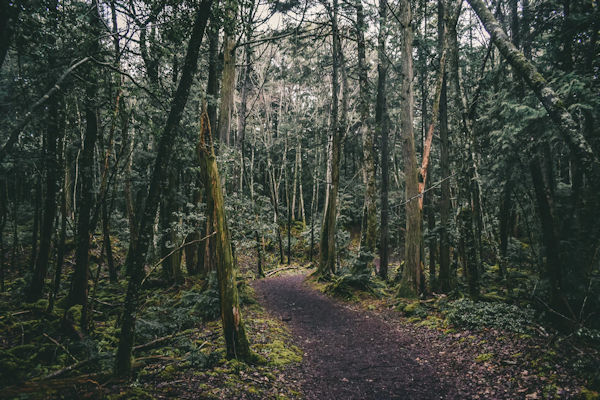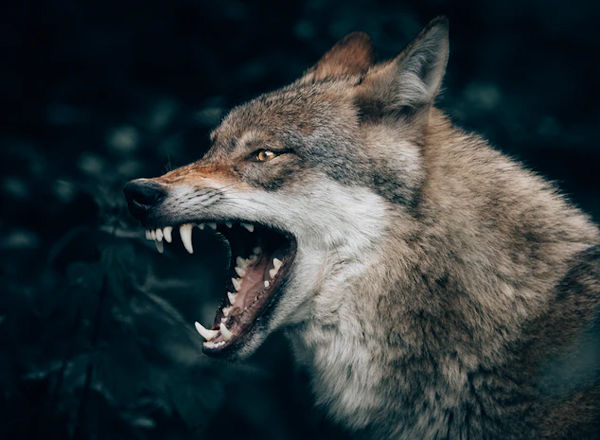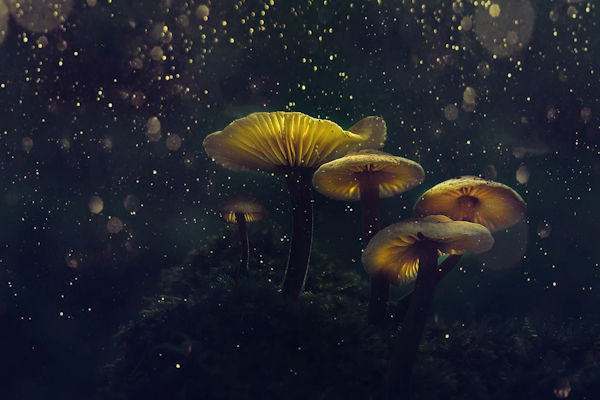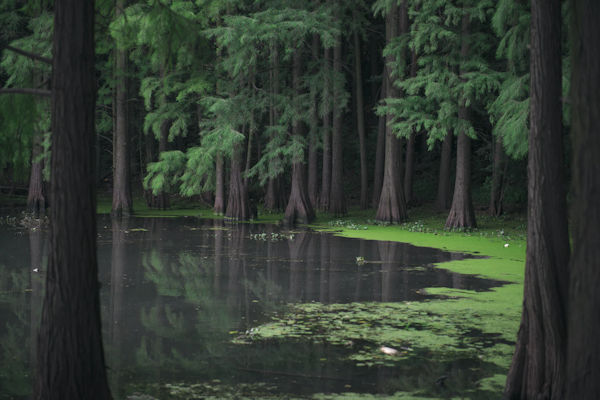
Forests have always been places of enchantment, haunted by outlaws, gods, angry ghosts and ferocious monsters. Walk a while with me.
The wind sings through the leaves. Birds squabble in their nests and animals great and small slink through the underbrush.
Trees older than cities slumber peacefully in hidden glades. Time moves to different rhythms in this place and we must move with it or be swallowed up by the vastness of the green.
Civilisation and the rules of humankind hold no sway here. There are greater powers at play. Diana, the virgin huntress and goddess of the moon, roams the woods. Woe betide any mortal man who stumbles across her. He will surely die, just as the young Greek Actaeon did—changed into a deer and torn apart by his own hounds for the crime of gazing upon unclothed divinity. Hern the Hunter, stag-antlered and feral, bays at the moon, calling to the primal and predatory instincts of mankind. He summons us to join the Wild Hunt or flee from it. The Green Man is his shadow; a being of leaves and vines that may symbolise the benevolence of nature, or its wrath.

Elves and faeries lurk in the shadows. They put a semi-human face on the sometimes hostile and inexplicable forces that govern the wilderness. Step into a ring of mushrooms and you could find yourself in another world. Wander into a faery celebration and say the wrong thing and you may find yourself cursed or blessed or torn apart.
You might join the faeries at their revels and have the night of your life, only to discover it has lasted for a hundred years. Or you might learn you have been adopted into the faery ranks so your soul can be offered up as a bargaining chip to the Devil himself. Such are the endless possibilities of the forest. Possibilities writers and cultures down the centuries have never tired of exploring.
Shakespeare’s Forest of Arden is a place where everything is thrown into flux. Women dress as men, the rich pretend to be poor, lovers deceive each other, those in exile are pardoned and wicked men repent their deeds. In the end, all is resolved, and all is well. The Athenian woods of A Midsummer Night’s Dream are a more explicitly magical place, where fey royalty make free with the bodies of mortals and you may not end a journey wearing the same head you started with. Although this play draws on Greek Mythology, the faery court are kinder than dread Diana and it’s possible to win love, fame and fortune if your luck holds out.

Far less kind is the tragic Aokigahara forest in Japan known as the Suicide Forest, which is said to be haunted by the pale ghosts of those who have gone there to hang themselves. The film The Forest explores this, creating a spectral world where time, place and even the evidence of your own eyes cannot be trusted. This forest is as much a part of the Otherworld, or even the Underworld, as it is a real location. And it hungers for more death and despair.
Ghosts are also said to infest the Malaysian jungle, hoping to trick the unwary into getting lost. These shades love to torment the living and draw them to their death. The Pine Barrens of New Jersey hold a more tangible threat—the eponymous Jersey Devil, a jumbled but murderous tangle of goat, horse, bat and kangaroo.
In the forests of Togo and Ghana you might be caught up by an Aswang—a predatory creature with hooked, iron feet and a thirst for blood. The tree-lined depths of Lithuania hold their own terrors. And if you look hard enough you may find five trees that were once humans—Egle, who married the Grass Snake Prince and became the Queen of the Serpents, and her four children who all failed to prevent the murder of their father.
For all its dangers, the forest is often seen as a place of opportunity, where adventure awaits, and fortunes can be made. Precisely because it is unknown and beyond human control, it can allow the bold and brave to rewrite the scripts of their own lives.

King Arthur’s knights set off into the wooded wilderness on their quests. By travel through the trackless forests they could gain treasures and resolutions that would never be found within mortal walls. To do the impossible, you go to where all rules can be broken or ignored. But beware the creatures that live there. The Green Knight who cannot be killed. The questing beast who cannot be caught. The dragon that winds between the trees and spits petrifying poison.
There have been humans who’ve made their homes in this ancient wilderness of course. And if a single visit into the sylvan realms can upturn your life, then what are the consequences of dwelling there permanently?
Most famous of these mythical forest-dwellers are Robin Hood and his merry men, who lived in untamed lands beyond the control of king and country. Robin Hood and his band led a cheerful life, free of responsibilities, which even Medieval folk must have daydreamed of. With this freedom came power, the power to upturn the social order and punish those who lorded over ordinary people—law officials, corrupt clergymen, nobles and even the king himself.
Many fictional royals and aristocrats have taken refuge in forests themselves. Snow White, FitzChivalry Farseer, The Raven King, Genevieve of Brabant and Queen Bellisant, to name but a few. This generally turns out to have been a wise move, in the long run.
Alas, the life of a real outlaw in Medieval England would have been far less idyllic than the tales of merry rogues that have been passed down to us. It likely would have been desperate, chilly and short. After all, another name for an outlaw in Medieval England was wolfshead. Which meant that they could be killed with impunity, just like a wolf.

True wolves or creatures like them also abound in folk tales, fairy tales and even historical accounts. The giant Beast of Gevaudan who terrorised France in the 18th Century. The Saga of the Volsungs, which tells of a father and son who donned wolf-skins and descended into a killing rage that led them to slaughter their way through a forest for ten days.
The Bedburg Werewolf—Peter Stubbe, a wealthy, farmer in 15th Century Germany. Dozens of the citizens of Bedburg were found, murdered and mutilated as if by a deranged animal or madman. We will never know the true cause, but Peter confessed to the murders after apparently being caught partway through a transformation from wolf to human. He confessed, perhaps under duress, to have viciously slaughtered and devoured men, women and children. He was put to death, the monstrous power of the wild tamed by the rule of law, or so it was thought at the time.
The classic werewolf is a dark mirror to the roguish outlaw. Where one mocks or overturns a corrupt social order and punishes the wicked, the other represents corruption itself. The werewolf is a human who rejects and defiles their own humanity, and consequently commits terrible crimes. Bear in mind that, unlike in many modern interpretations, Medieval werewolves were often thought to be in league with the devil and willingly don a wolfskin or magical belt in order to carry out their monstrous transformations.
Witches too are said to work their magic in woods. Modern Pagans and Wiccans may draw on the positive connotations of the forest, seeking to get closer to nature or to draw upon its symbolism of wildness, growth and rebirth to power their own rituals and practices. Similarly, modern ideas of werewolves sometimes cast them as noble defenders at one with a more primal world.

Medieval paranoia and superstition painted a far stranger and wickeder picture, of blood sacrifice, ritual abasement and crazed Satanists running through the woods in the form of dogs, deer, hares or cats. These images still fascinate us to this day, immortalised in serious works of horror like Robert Egger’s film The Witch or Scott Snyder et al’s novel Wytches, in humorous stories like the film The Little Hours and in those that slink uncomfortably between the two, like The Chilling Adventures of Sabrina TV series.
Nor is this idea of forbidden powers connected to the wild unique to Europe. For example, tales told by the Navajo speak of naaldlooshii or skin-walkers, people who pervert the ceremonies of medicine men and women, work evil magics and transform themselves into animals. Skin-walkers represent the antithesis of the cultural values of the Navajo. They are the wilderness given a hostile but somewhat human face.
A less frightening cousin to the werewolf is The Big Bad Wolf, eater of pigs and grandmothers, and a warning to young maidens not to talk to strange hairy men in the woods. (And to very definitely not let those strange men convince them to disrobe and climb into bed together, as happens in the original French version of the story.)
It’s not just cautionary tales about rampant of male sexuality that can be found personified in forest myths. In Scandinavian folklore, hulder women demand sex from passing men and murder them if the experience isn’t satisfying enough. In Ireland, Leanan sídhe lure men into vampiric love affairs and slowly drain the life from them. In Russia, rusalka seduce and drown men in forest pools. As with so much of human folklore and history, it’s only one short step from desiring a woman, to demonising her.

Of course, the forest itself has power and agency. Listen closely to the wind as you pass through the many paths of the forest and you may hear dryads whispering from the trees. In Greek Mythology these minor goddesses were fairly harmless and feared the attention of the Olympians as much as mortals did. Modern fantasy writers often depict them as more powerful and certainly more perilous. In the Discworld they are vengeful spirits that will entrap and sacrifice anyone who harms their tree. In the now destroyed world of Warhammer Fantasy they went to war alongside the Wood Elves, taking the form of spiteful, woody creatures that rent their enemies with jagged wooden claws.
All of this calls back to the fury of the Ents, the massive tree-men dreamed up by Tolkien; titans who can slaughter cave-trolls and tear down the walls of a fallen wizard’s castle. They represent Tolkien’s hatred for industrialisation and the terrible destruction he saw it wreak upon the fields of France in the First World War. When we seek to come to terms with our own fears for the environment, and our anger and guilt at the harm that we and those like us have wrought upon it, we put a human face on the trees and imagine they are coming to avenge themselves.
Conversely, Tolkien’s Mirkwood has a less wholesome aspect. This is a wood that has been infected by the evil of Sauron and now hides goblins and giant spiders amongst its “dark firs”.
The name Mirkwood had been used already by two 19th Century writers, Sir Walter Scott and William Morris, both seeking to evoke a sense of lonely distance from the lights of civilisation. Going further back in time, there are Norse myths that speak of mirkwoods or dark woods and the things that wander there.

In Naomi Novik’s novel Uprooted the forest is an actively malevolent force on its own, stealing children and adults alike and either corrupting them or devouring them whole. Other authors present the wilderness as a place of ambiguity, where good and evil are matters of perspective, if they exist at all.
Christian Cameron, under his nom-de-plume of Miles Cameron, writes The Wild as a thing without morality. The Wild is a territory, a force and a state of mind, and all of these recognise only power. It is a place of horror, where insectoid creatures may swarm over a human warrior and devour him alive. But also, a place of wonder where gryphons play and the Irks, hideous and serpentine in war, become beautiful and elfin in peace.
In Jeffrey Ford’s Well-Built City trilogy, the vast forest known as The Beyond defies all attempts at exploration or categorisation. Entire lost civilisations lurk in its depths. Paradise may be found along one path and death along a thousand others. A war was waged here between fish people and an army of eternally resurrecting plant warriors and no one in the civilised lands ever knew. It cannot be brought to heel. But it is possible to embrace it, to learn its ways and so to be transformed into something new.
In Brian Catling’s Vorrh trilogy, the Vorrh is a forest that also has links to paradise and Abrahamic Mythology, but is placed in Africa and may draw on folklore from there as well. It is a place where time is uncertain, identity is stripped away and those who stay too long can become living zombies, possessed of little will of their own and animated only by foul and inexplicable desires.
In Robert Holdstock’s novel Mythago Wood, a forest called Ryhope Wood holds the curious property of allowing people to unconsciously generate archetypal beings called Mythagos from their own conceptions of mythical figures like Robin Hood. The results can be wondrous, terrifying or both. The wood itself offers the chance to travel beyond the known world and into landscapes of myth and legend that otherwise exist only in dreams.
This is the central truth that all these authors tap into. The forest may represent danger, chaos and the Other. But we contain all of these things within our own mind. The forest—trackless, primeval and full of uncontrollable powers—is a mirror for our own subconscious.

Title image by Johannes Plenio.

